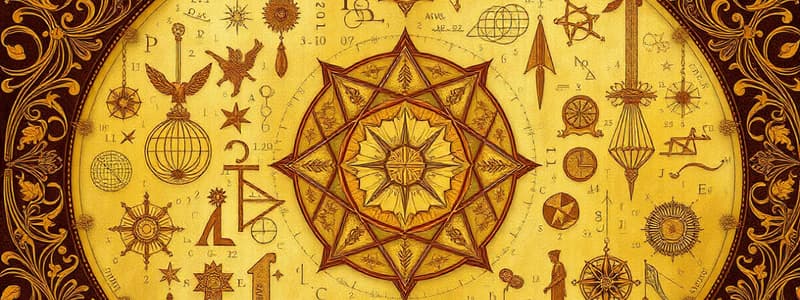Podcast
Questions and Answers
Which of the following is a branch of mathematics that deals with the study of continuous change?
Which of the following is a branch of mathematics that deals with the study of continuous change?
- Algebra
- Geometry
- Trigonometry
- Calculus (correct)
What is the process of finding the difference between two numbers called?
What is the process of finding the difference between two numbers called?
- Multiplication
- Division
- Subtraction (correct)
- Addition
Which branch of mathematics studies mathematical symbols and the rules for manipulating them?
Which branch of mathematics studies mathematical symbols and the rules for manipulating them?
- Arithmetic
- Geometry
- Algebra (correct)
- Calculus
What are statements that are assumed to be true without proof called?
What are statements that are assumed to be true without proof called?
Which of the following is NOT a basic operation in arithmetic?
Which of the following is NOT a basic operation in arithmetic?
What is the name for mathematical statements that show the equality between two expressions?
What is the name for mathematical statements that show the equality between two expressions?
Which of the following is concerned with the properties and relations of points, lines, surfaces, and solids?
Which of the following is concerned with the properties and relations of points, lines, surfaces, and solids?
Which branch of mathematics deals with the likelihood of an event occurring?
Which branch of mathematics deals with the likelihood of an event occurring?
What term describes properties of geometric objects that remain the same when they are stretched, twisted, or bent?
What term describes properties of geometric objects that remain the same when they are stretched, twisted, or bent?
What is a logical argument that establishes the truth of a theorem called?
What is a logical argument that establishes the truth of a theorem called?
Flashcards
Mathematics
Mathematics
The study of quantity, structure, space, and change.
Axioms
Axioms
Statements assumed to be true without proof.
Theorems
Theorems
Statements proven true based on axioms and previously proven theorems.
Proof
Proof
Signup and view all the flashcards
Equation
Equation
Signup and view all the flashcards
Variables
Variables
Signup and view all the flashcards
Descriptive Statistics
Descriptive Statistics
Signup and view all the flashcards
Inferential Statistics
Inferential Statistics
Signup and view all the flashcards
Probability
Probability
Signup and view all the flashcards
Topology
Topology
Signup and view all the flashcards
Study Notes
- Mathematics involves studying quantity, structure, space, and change.
- It lacks a generally accepted definition.
- Mathematicians identify and utilize patterns to create new conjectures, determining their truth through mathematical proofs.
Branches of Mathematics
- Arithmetic studies numbers and basic operations like addition, subtraction, multiplication, and division.
- Algebra focuses on mathematical symbols and rules for manipulating them.
- Geometry deals with properties and relations of points, lines, surfaces, solids, and higher-dimensional analogs.
- Trigonometry studies relationships between angles and sides of triangles.
- Calculus involves the study of continuous change.
- Statistics includes the collection, analysis, interpretation, presentation, and organization of data.
- Probability deals with the likelihood of events occurring.
- Topology studies properties of geometric objects preserved under continuous deformations like stretching, twisting, crumpling, and bending, but not tearing or gluing.
- Number Theory concerns the properties and relationships of numbers, especially integers.
- Discrete Mathematics studies mathematical structures that are fundamentally discrete rather than continuous.
Key Mathematical Concepts
- Axioms are statements assumed true without proof.
- Theorems are statements proven true based on axioms and previously proven theorems.
- Proofs are logical arguments establishing the truth of a theorem.
- Conjectures are statements proposed as true but not yet proven.
- Models are abstract mathematical descriptions of real-world systems or phenomena.
Arithmetic in Detail
- Arithmetic focuses on basic operations.
- Addition combines two or more numbers to find their total.
- Subtraction finds the difference between two numbers.
- Multiplication is repeated addition.
- Division splits a number into equal parts.
Algebra in Detail
- Variables are symbols representing unknown quantities.
- Equations are mathematical statements showing equality between two expressions.
- Polynomials are expressions with variables and coefficients, involving addition, subtraction, multiplication, and non-negative integer exponents.
- Functions are relationships between two sets where each input relates to exactly one output.
- Solving equations involves finding variable values that make the equation true.
Geometry in Detail
- Points are locations in space.
- Lines are an infinite number of points extending in opposite directions.
- Planes are flat, two-dimensional surfaces extending infinitely.
- Shapes are two-dimensional figures defined by their boundaries (e.g., triangles, squares, circles).
- Solids are three-dimensional figures defined by their surfaces (e.g., cubes, spheres, pyramids).
- Transformations change the position, size, or shape of a geometric figure (e.g., translation, rotation, reflection, scaling).
Trigonometry in Detail
- Trigonometric Ratios relate sides of a right triangle to its angles (sine, cosine, tangent, cotangent, secant, cosecant).
- Unit Circle is a circle with a radius of 1 used to define trigonometric functions for all real numbers.
- Trigonometric Identities are equations true for all defined values of the variables.
- Applications include navigation, surveying, engineering, and physics.
Calculus in Detail
- Differential Calculus studies rates of change and slopes of curves.
- Integral Calculus studies accumulation of quantities and areas under and between curves.
- Limits are the value a function "approaches" as the input approaches some value.
- Derivatives measure the rate of change of a function with respect to its input.
- Integrals measure the accumulation of a quantity over an interval.
- Applications include physics, engineering, economics, and computer science.
Statistics in Detail
- Descriptive Statistics summarizes and describes data (e.g., mean, median, mode, standard deviation).
- Inferential Statistics makes inferences about a population based on a sample of data.
- Probability Distributions are functions describing the likelihood of different outcomes in a random experiment.
- Hypothesis Testing tests claims about a population using sample data.
- Regression Analysis models the relationship between variables.
Probability in Detail
- Events are sets of outcomes of a random experiment.
- Sample Space is the set of all possible outcomes of a random experiment.
- Probability measures the likelihood of an event occurring.
- Conditional Probability is the probability of an event occurring given that another event has already occurred.
- Independent Events are events whose probabilities are not affected by each other.
Topology in Detail
- Homeomorphism is a continuous deformation that preserves the essential properties of a shape.
- Topological Spaces are sets with a structure allowing definitions of continuous deformations.
- Applications include computer graphics, data analysis, and physics.
Number Theory in Detail
- Integers are whole numbers (positive, negative, and zero).
- Prime Numbers are numbers divisible only by 1 and themselves.
- Divisibility is the property of one number being divisible by another without a remainder.
- Congruences are relationships between numbers that have the same remainder when divided by a given number.
- Applications include cryptography and computer science.
Discrete Mathematics in Detail
- Logic deals with the principles of reasoning.
- Set Theory studies sets, which are collections of objects.
- Graph Theory studies graphs, which are mathematical structures modeling pairwise relations between objects.
- Combinatorics deals with counting and arranging objects.
- Applications include computer science, operations research, and engineering.
Mathematical Notation
- Symbols represent concepts, operations, and relationships.
- Clarity ensures clear and unambiguous communication of mathematical ideas through proper notation.
- Consistency via standardized notation allows mathematicians worldwide to understand each other's work.
Mathematical Proofs
- Logical Reasoning constructs proofs using logical deduction from axioms and established theorems.
- Rigor requires each step in a proof to be justified.
- Methods of Proof include direct proof, indirect proof (proof by contradiction), and proof by induction.
Applications of Mathematics
- Science relies heavily on mathematical models and techniques within physics, chemistry, biology, etc.
- Engineering uses math to design and analyze structures, systems, and algorithms.
- Computer Science relies on mathematics as the foundation of algorithms, data structures, and computer graphics.
- Economics uses math to model economic systems, analyze markets, and make predictions.
- Finance uses math to price financial instruments, manage risk, and analyze investments.
Studying That Suits You
Use AI to generate personalized quizzes and flashcards to suit your learning preferences.




